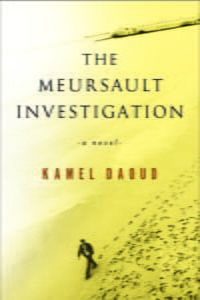Re-encountering “The Stranger”: A Review of “The Meursault Investigation”
 By Cora Lee Womble-Miesner
By Cora Lee Womble-Miesner
Some authors can put their ear to a novel and hear what is being smothered underneath: the flip side of a coin, the antagonist’s backstory. In reimagining a book from a different perspective, an author can shape a new interpretation of a classic text. What “Wide Sargasso Sea” is to “Jane Eyre,” Kamel Daoud’s “The Meursault Investigation” is to Albert Camus’s “The Stranger.” Daoud lends a penetrating new angle to the philosophical novel by writing from the perspective of Harun, the brother of the Arab man that Meursault kills, voicing the aftermath of this death on their family and community and the torment caused by the victim’s unnaming in the media coverage and “memoir” that followed. In this impassioned retelling, “The Stranger” is not a novel, but Meursault’s own non-fiction recounting of his crimes which propelled him into fame, making him a household name, while Harun’s murdered brother, Musa, is ignored and forgotten by the public eye. The narrator denounces Meursault, saying, “If he hadn’t killed and written, nobody would have remembered him.”
This vigorous and interrogative work is the author’s debut novel. Daoud is a seasoned Algerian journalist whose articles have been reprinted across the globe. Written as a one-sided conversation between Harun and an unvoiced Westerner he meets in a bar—reminiscent in form to Mohsin Hamid’s “The Reluctant Fundamentalist,” but also entirely his own—it is a story that “takes place somewhere in someone’s head, in mine and in yours and in the heads of people like you. In a sort of beyond.” Harun’s life is hijacked by the death of Musa when he is a young boy. He becomes an ill-fitting substitute to fill the hole left in his mother’s psyche, and he is constantly trailed by a shadow: his brother, but also the unshakeable presence of his brother’s killer. Daoud poignantly parallels Harun with Meursault, feeding into the theme of doubling that runs intricately through the novel. While Harun spends the entire book disparaging Meursault, they have more commonality than he may want to acknowledge: both men have complicated relationships with their mothers, both have absent fathers, both become fixated on newspaper clippings. Yet where Meursault is chilled and unemotive, Harun bubbles over with feeling, seeking answers for his brother’s senseless death: “You can get dizzy thinking about it, how a man could lose his name, plus his life, plus his own corpse, all in a single day.” Harun is not quite Meursault’s double, but not his opposite either. Through the course of the storyline one thing is evident: he is a heartrending, complicated, lifelike character fixed on the page by an expert hand.
“The Meursault Investigation” launches with “Mama’s still alive today,” a recasting of the infamous “Aujourd’hui, maman est morte,” that places Daoud in conversation with Camus and readies the reader to investigate the correspondence between the two books. There is no shortage of parallel, and uncovering them is a literary scavenger hunt. “The Meursault Investigation” must be read with a close eye. The story is recounted in a fragmented manner that mirrors the narrator’s patchwork of memories; he states toward the end, “I would have preferred to tell you all these things in the proper order . . . but too bad, you’ll be able to sort it out.” And he’s right. The pleasure (and pain) of this novel is sifting through Harun’s memories, piecing together the past to reveal the tapestry of grief: not only an individual’s bereavement, but also the residue of post-colonial trauma left in Algeria after the French occupation. Daoud firmly reminds us to examine a narrative for what is being erased—no one is silent, they just may be unheard.
Cora Lee Womble-Miesner is a former grocery store stocker, dog-walker, card-turner, boxing instructor, assistant landscape gardener, and editorial intern, and is currently a barista, nanny, and house-cleaner. She spent the first twenty-two years of her life in San Diego, CA before transplanting to NYC.

